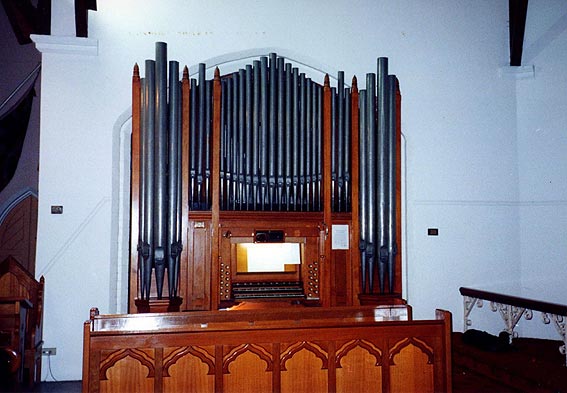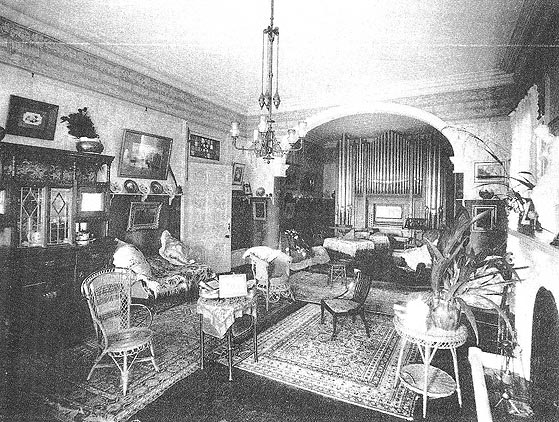St Augustine's Anglican Church
Merewether
B. unknown, Reb.1964 S.I. Sakacs, Melbourne., 3m., 16 sp. st., 8c., tr.
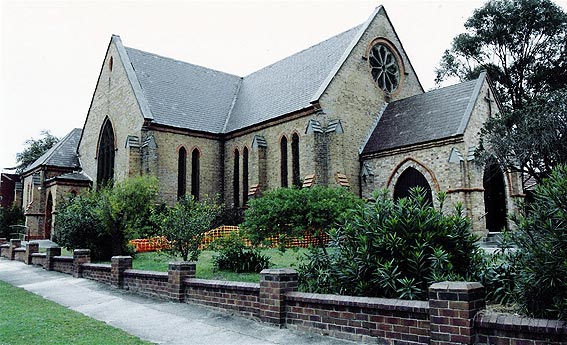
From 1990 OHTA Conference booklet:
The organ in this church is of uncertain origin and has evolved as successive organbuilders have left their mark. The instrument was installed from England in the home of John St Vincent Welch at Lane Cove in Sydney. At some stage it is possible that William Davidson had a hand in alterations, as many internal parts bear strong resemblance to his style. [1] The organ was installed at Merewether in 1924 by Alex. J. Hunter. [2] In 1964 S. I Sakacs, of Melbourne, completely remodelled the tonal aspect of the organ/
David Evans adds [April 2006]:
The church was opened in May 1889 and was the gift of Mr E. C. Merewether.
The organ is located in the choir vestry at the left of the chancel. The builder is not known, but it was purchased by St Augustine's and installed by Alex J. Hunter in 1924 from the Lande Cove residence, Standish, of John St Vincent Wlech who settled in Sydney in 1874.
Research by John Stiller in 1981 indicates that the organ could have been built by Davidson. Many of the ranks have been repositioned or changed. It was rebuilt by S. I. Sakacs, Melbourne, in 1964 and renovated by J.W.Walker, Sydney in 1983.
The organ is no longer used and has been replaced by an electronic. The church is trying to sell it.
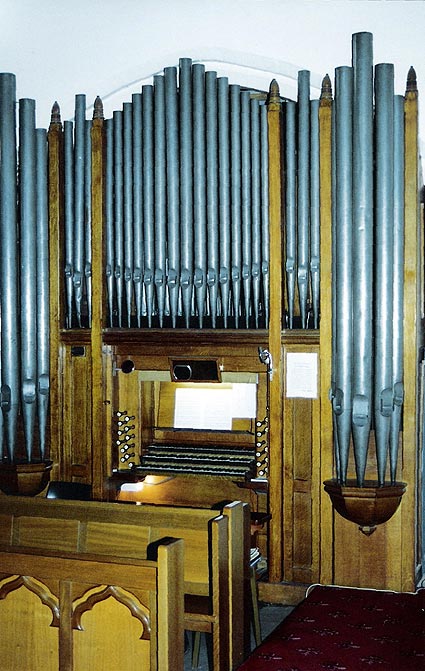
The specification is:
| Great Open Diapason Hohl Flute Viola Harmonic Flute Swell Bourdon Violin Diapason Stop Diapason Principal Fifteenth Oboe Choir Wald Flute Dulciana Lieblich Flute Clarionet Pedal Bourdon Flute Couplers Swell to Great Swell to Choir Choir to Great Swell Octave Swell Sub Octave Great to Pedal Swell to Pedal Choir to Pedal |
8 8 8 4 16 8 8 4 2 8 8 8 4 8 16 8 |
Compass 61/30
5 composition pedals
Mechanical action
[1] John Stiller, Documentation of Pipe Organ installed in 1924 - St Augustine's Anglican Church, Merewether (OHTA 1981), 2.
[2] Rushworth, Historic Organs, op.cit., 159
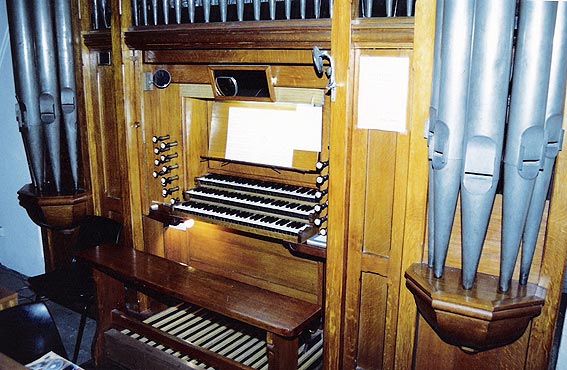
Photos above: TB
From SOJ Spring 2006:
Richard Baker reports:
There has always been something of a question about the origin of the organ in St Augustine's Anglican Church, Merewether (a Newcastle suburb), and now there is a new question over its future.
This article attempts to provide as full an account of the history of the organ as possible, and seeks to correct some errors of fact which have crept into the record over time. In the course of its preparation one or two other interesting details have emerged which give colour to the overall tale.
Concern about what could be happening to the Merewether organ prompted the Hunter District Organ Music Society Committee to write to the Rector of St Augustine's, and this letter, together with his reply, is included here.
On 27.11.2005 the Secretary wrote:
“I am writing on behalf of the Hunter District Organ Music Society to express the Society's concern about the future of the historic three manual pipe organ in St Augustine's church. At present various rumours about what might be happening to the organ are circulating. These rumours may well be speculative and it would be appreciated if you could advise us on what is proposed for the organ.
As you know, the organ was originally built for the residence of John St Vincent Welch in Lane Cove in Sydney. Some of the pipework is by William Davidson, one of the most significant organ builders in nineteenth century New South Wales. The organ, which cost £900, was installed by A J Hunter in St Augustine's at a cost of £110. The organ is certainly part of the overall pipe organ heritage of New South Wales and the Hunter region.
That the organ was overhauled and altered in an illconceived fashion by an Australian organ builder in 1964 is well known and this is the basis of current difficulties which may be experienced with the instrument, particularly the inadequate and unsteady wind supply. But the problems could undoubtedly be set right if a sympathetic restoration was undertaken by a competent builder, working under currently accepted heritage guidelines. Such a restoration would provide many more years of reliable service. Some of our members have played it recently and remarked that it is a good organ.
The Society hopes that no precipitate steps will be taken concerning the future of this significant instrument - one of only five three manual pipe organs in the Hunter region - but that everything will be done to safeguard its preservation and continued use.”
On 30.11.2005 the Rector, Fr Stephen Williams, replied:
“Thank you for your letter expressing interest in the pipe organ at St Augustine's. As your members are doubtless aware a new instrument designed to better serve the church's needs has now been installed and was blessed by the Bishop on 20 November 2005.
We respect the heritage concerns that people have, and Parish Council is mindful also of strong sentimental interest in the organ which was installed in 1924. Indeed it is the heritage interest which prevents its being upgraded, expanded and modernised that led to our decision to replace it. The limitations of the organ and the costs associated with repairs now required which led us to replace the organ are perhaps likely to discourage another church from acquiring it from us, but we have asked Peter Jewkes to keep his eyes open for someone who might give it a good home. A museum has expressed verbal interest and it is possible that some private person might be interested, it having been built for and used in a private home in Sydney before it came to Merewether. Your members may be able to offer some ideas. No decision on the future of the organ has been nor can be made until all possibilities have been explored.
Thank you again for your letter. I can assure your members that decisions in relation to our new musical instrument were made only after careful research, long debate and energetic discussion. We also consulted with organ experts and obtained reports from them. St Augustine's is a lively community of faith committed to excellence in worship and community service. Music has a crucial role to play in our life together and in our care of the people of Merewether and of the city. We value the contribution that the pipe organ has made in the past and hope that people can enjoy it for many years to come. It does not, however, meet our needs. Please pass on my good wishes to your members.”
The Rector's reply indicates that no immediate action to remove the organ or dispose of it summarily is contemplated, but that re-location to another institution would ultimately be an acceptable step from the point of view of the parish, which does not appear to want to retain the instrument in the long term or invest any money in rectifying some of the problems which currently affect it.
A tentative chronology of the organ.
While many facts are known many others are not and may never be, or remain a matter of speculation. There is still debate about whether the instrument is English in origin, or built by William Davidson in Sydney. This chronology is an attempt to note the key stages in the life of the instrument, taking both these conflicting views into account.
The view that the organ was built by Thomas Liddiatt in England dates it to around the early 1870s. The thought is that it was brought to Australia by John St Vincent Welch in the early 1870s, and installed at his residence Standish after the house was built in 1892. The organ remained in the house until 1919, after which it was put into storage. In 1924 the organ was bought by the Merewether parish and installed in the church, where it has been in use until recently.
The argument that William Davidson was the builder would date the organ to the 1890s. The idea of Davidson being the builder is supported on the St Augustine's parish website. In his documentation John Stiller, while favouring Liddiatt, noted the undoubted indications of Davidson having been involved in work on the instrument. However Graeme Rushworth, while covering Welch's contribution to the building of the great William Davidson organ in St Thomas', North Sydney, does not make any mention of him having been involved in building or re-building an organ for his own residence.
It is known that an electric blower, located in an outside housing, was installed at some stage after the organ was set up in St Augustine's, but so far it has not been possible to confirm the date when this occurred. Nor has it been possible to find out if any other significant developments occurred between 1924 when the organ was set up in St Augustine's and 1964 when the organ was 're-built' by S. I. Sakacs. Many of the present difficulties with the organ can be directly attributed to this misguided and third rate re-build.
For many years regular tuning and maintenance was carried out by S. T. Noad. Latterly, Peter Jewkes has had care of the organ. John Stiller wrote a documentation of it in 1981. At some stage a number of the ranks on the organ were transposed, as noted by John Stiller. Whether this was done by Sakacs or at some other time is not clear. J. W. Walker undertook work on the organ in 1983. In the early years of this century the parish decided to replace the pipe organ with an electronic instrument and this occurred at the end of 2005. At present the pipe organ remains in the church, effectively redundant, pending a decision as to its future.
The story of the organ.
While most organs can be thought of as being 'unique' the Merewether instrument is a particularly unusual one. Indeed, because it is so difficult to be certain about many details relating to it, it could well be termed 'The Amazing Mystery Organ of Merewether'.
Firstly, if it is thought to be primarily of English origin, it is not the creation of one builder but is made up of elements contributed by various hands from several sources. There is still some question about the origin of some of its constituent parts, but here is what appears to be a reasonable summary of its probable makeup. The console, original wind supply and reservoir, and mechanical note and stop action, may be by the minor English builder Thomas Liddiatt. Liddiatt's operations were based in two tiny villages, Leonard Stanley and subsequently Kings Stanley, near Stonehouse in southern Gloucestershire, from around the 1860s. Liddiatt was primarily a reed organ manufacturer, making 'Stanley' reed organs, but was also involved to some extent in building and working on pipe organs.
Some accounts have associated Liddiatt with the town of Standish. However neither Thomas Liddiatt nor any of his sons, who continued his business, had any association with Standish, where the first owner John St Vincent Welch later lived for some years, and never carried on business there. Standish is a great deal further north in Lancashire, and this is one of the confusing pieces of mis-information which has grown up and been repeated in different accounts about the organ. However it is possible that there was confusion between 'Stanley' and 'Standish,' and this may be how the error crept in. The firm was continued into the twentieth century by Liddiatt's three sons, being ultimately taken over by Osmonds of Taunton in the 1940s.[Information about Liddiatt supplied by English organ authority Ian Bell. There is no mention of Liddiatt in AWJG Ord-Hume's classic Harmonium - the story of the reed organ and its makers.]
It seems that Liddiatt did not supply pipes, or if he did they may have been lost in transit to Australia and were supplied later. Stiller attributes the metal pipework to Fincham and some of the wooden pipework to Davidson. The exact date when the organ was built is not clear - probably some time in the early 1870s - but if this version of its origin is accepted it seems that it probably came to Australia with Welch when he arrived in Melbourne in 1873 and settled in Sydney in 1874.
The alternative, as discussed above, is that the organ is by William Davidson and was built in the 1890s - maybe at the request of John St Vincent Welch. It would be fair to say that the jury is still out on this whole question. If any of our readers have ideas or information on this matter it would be interesting to have their comments.
From about 1892 to 1919 the organ was in the drawing room of John St Vincent Welch's residence Standish in River Road, Greenwich, on Sydney's lower north shore.
The History of the Parish of Merewether.
The parish of St Augustine's, Merewether, dates from 1888, prior to which Afghans in the area attended St John's, Cooks Hill. The notable Newcastle figure, E. C. Merewether built the church, which was completed in 1889 and initially leased back to the parish for 999 years. This was a highly unusual and unsatisfactory arrangement, and the title deeds of the church were ultimately handed over to the Church of England authorities in 1913. The parish website sets out this background as well as stating that the organ was built by Davidson.
St Augustine's is a substantial brick church, seating about 240. A reed organ was first used to accompany services but would have been inadequate in such a building and there was always the hope that it could be replaced by a pipe organ. Revd A. H. Venn became Rector in the early 1920s - putting determination into this aim and soon the wish became a reality.
The organ was purchased by the Merewether parish from the Welch family for £900 and installed in St Augustine's in 1924 by the Sydney organ builder A. Hunter at a cost of £110. [Rushworth, Historic Organs of NSW, pp 158-159] (A loan of £250 from the Diocese of Newcastle helped the purchase and the whole cost was paid off in six years.)
Later, at a time which it has not been possible to verify, hand blowing was replaced by an electric blower located in an external housing adjacent to the organ chamber. The blower motor would probably have operated on 415 volts and the wind was conveyed to the organ by terracotta piping running under the ground. The whole apparatus would have been quite noisy, which is why it was placed outside the organ chamber. Nothing now remains of this structure apart from the concrete slab. Nothing remains of the hand blowing system.
The organ is situated in the church in a chamber on the north side of the chancel and the main display pipes face into the chancel. These are made of burnished zinc, and incorporate pipes from the Great Open Diapason and Harmonic Flute. Other metal pipework in the organ is of spotted metal. The casework is of English oak. There is a small set of dummy display pipes on the west side of the chamber.
The Stiller documentation.
John Stiller undertook this on behalf of OHTA in June 1981. Some facts are noted:
“This organ was originally in the possession of Dr John St Vincent Welsh. It is believed that it was built in England by a minor organ builder, Liddiatt, at Standish where John St Vincent Welsh lived before coming to Australia. Apparently Dr Welsh bought the organ for his wife, who played the organ, and it was brought to Australia when he emigrated here. Dr Welsh's wife died, and the organ fell into disuse and ultimately was removed from the house and placed in storage. It then became derelict and was damaged by rats and mice.
In 1924 the organ was purchased by St Augustine's, Merewether. Total costs amounted to more than £1,000. In 1964 the organ was 'rebuilt' by Mr S. I. Sakacs. Unfortunately the original double-rise bellows was discarded at this stage and replaced by a leather diaphragm system. At the same time the Swell Voix Celeste was altered to form a Fifteenth, new tin pipes being added to complete the upper end of the compass. The casework was revarnished in 1964 to match the new choir stalls. Numerous alterations have been made to the specification of this organ, and several ranks of metal pipework have been transferred from one manual to another.”
Unfortunately, some of what is stated in this paragraph is not correct. Stiller goes along with the argument that Liddiatt was the builder and that Welch probably brought the organ with him when he came out to Australia in the 1870s. However, it was after he came to Australia that he married, and Welch was survived by his widow, who lived until 1927. Stiller mis-spells Welch's name, and makes him a doctor. Welch was not a doctor, but all of his four sons were. Stiller also perpetuates the inaccurate association between Liddiatt and Standish which was never correct.
Numerous alterations have been made to the specification of this organ, and several ranks of metal pipework have been transferred from one manual to another. These changes are now summarised, and the original specification is based on metal pipework inscriptions.
| Original Specification | Present Specification | |||||
| Great Open Diapason Stop Diapason Dulciana Principal Swell Bourdon Gamba Hohl Flute ? Voix Celeste Oboe Choir Wald Flute Salicional Lieblich Flute Clarionet Pedal Double Diapason Bass Flute Couplers Swell to Great Swell to Choir Choir to Great Swell Octave Swell Sub Octave Great to Pedal Swell to Pedal Choir to Pedal |
8 8 8 4 16 8 8 ? 8 8 8 8 4 8 16 8 |
transferred to Swell transferred to Choir transferred to Swell transferred to Great transferred to Great as Viola |
Great Open Diapason Hohl Flute Viola Harmonic Flute Swell Bourdon Violin Diapason Stop Diapason Principal Fifteenth Oboe Choir Wald Flute Dulciana Lieblich Flute Clarionet Pedal Double Diapason Bass Flute Couplers Swell to Great Swell to Choir Choir to Great Swell Octave Swell Sub Octave Great to Pedal Swell to Pedal Choir to Pedal Tremulant |
8 8 8 4 16 8 8 4 2 8 8 8 4 8 16 8 |
new pipework and transposed ex Swell ex Choir new pipework original renamed ex Great ex Great altered original original ex Great original original no change no change not original |
|
The presence of a large amount of wooden pipework which has a style of workmanship consistent with the techniques of William Davidson (Sydney) places a certain amount of doubt on the authenticity of the above historical account. In fact apart from the keyboard cheeks and style of stoppers in the metal pipework, this organ is a textbook example of William Davidson's organbuilding style. It is possible that he entirely rebuilt the instrument late last century.
Other alterations which have been undertaken on the organ include:
1. The addition of tuning slides on all open metal pipework
2.The removal of the hand-blowing apparatus (now said to be in an enclosure outside the church)
3. The addition of a Tremulant
4. The replacement of the original Swell box with one having vertical shutters.
This is an abridgement of the first of two detailed articles on this organ written by Richard Baker and published in Plenum, Vol 28 No 2. Publication of Part 2, proposed to follow is under question following the death of Mr Baker in June 2006. The article is published by kind permission of the Hunter District Organ Music Society.
© PdL 2006
Installed in 1924 from residence of John St Vincent Welch, Esq., Wollstonecraft, Sydney
[Photo supplied by PdL]
